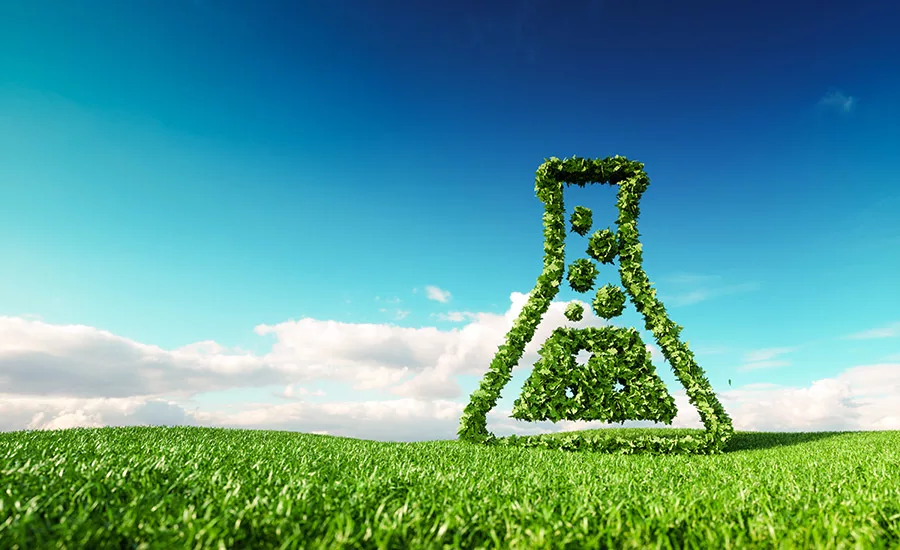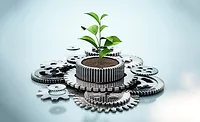Supplier of Latex Binder Solutions Tackles Issues Surrounding Sustainability
Arthas Yang of Trinseo explains how his company is minimizing the environmental impact of its products to meet growing demands from consumers.

Petmal / iStock / Getty Images Plus
In today’s environment of ever-evolving environment-friendly initiatives and goals, it is important for adhesive and sealant manufacturers to source materials from companies that share their same commitment to sustainability. This will become even more important as companies work to quantify their Scope 3 emissions. Scope 3 emissions are emissions produced on either side of a company’s supply chain – by customers using their products and companies supplying raw materials used to manufacture products. Tackling targets for Scope 3 emissions is a big task and requires a new level of cooperation and transparency within industries.
Trinseo provides latex binder solutions to adhesive manufacturers worldwide. The company offers styrene butadiene, styrene acrylic, vinyl acrylic, pure acrylic, vinylidene chloride and bio-hybrid chemistries to the adhesives industry. Focusing on both sustainable and high-performance solutions, the company has been in business for 70 years.
 Arthas Yang
Arthas Yang
ASI asked Arthas Yang, global business director, CASE, Trinseo, Zurich, Switzerland, about how his company is minimizing the environmental impact of its products to meet growing demands from consumers for more eco-friendly products.
ASI: What steps has your company taken to minimize the environmental impact of your products?
Arthas Yang: As a specialty materials provider, Trinseo is constantly looking for ways to deliver innovative, high-performing, and sustainable solutions. We believe this begins with sustainable manufacturing processes such as the International Sustainability & Carbon Certification’s (ISCC) mass balance approach. This chain of custody model allows us to accelerate our uptake of sustainable feedstocks in our existing value chains while tracking the flow of both sustainable and non-sustainable materials throughout production. The ability to trace our sustainable materials ensures that a product’s sustainability characteristics are transparent and auditable, in turn allowing us to validate our sustainability claims.
To further understand the environmental impact of our solutions, Trinseo also uses Life Cycle Assessments (LCA). LCAs offer quantifiable evidence of our materials through every stage of their life. This evidence can then be shared with industry-wide eco-profiles globally to provide an accurate profile of a product’s classifications and potential hazards. We also calculate the Product Carbon Footprint (PCF) of our materials in order to measure the total greenhouse gas emissions generated by a product. The ability to measure a product’s environmental impact is crucial as it provides actionable data to guide our research and development processes.
Trinseo also reviews our current product offerings to determine where our customers’ sustainability needs may be. One such example is the creation of our CO2NET™ product portfolio. CO2NET™ binders are designed to generate at least 50% fewer carbon emissions than their fossil-based counterparts and are manufactured using a mass balance approach. Furthermore, Trinseo manufactures and markets bio-hybrid binders that contain renewable biopolymers to meet the CO2NET™ emission reduction requirements.
Our continued analysis of a product’s environmental impact allows us to enhance the development of more sustainable products without impacting a customer’s performance needs. Trinseo’s multi-pronged approach to product development and measurements ensures we can continue to meet our goals of providing high-performing, sustainable solutions.
ASI: What role does transparency play as you work with suppliers and customers to achieve your sustainability goals?
Yang: Transparency is a crucial component of our sustainability work and is evident in our efforts to track a product’s environmental impact. LCAs and PCFs validate a product’s sustainability claims, which is critical as we work collaboratively with our customers in developing solutions to meet their performance and environmental goals. Without this data, the Trinseo team could not accurately and honestly portray our solutions.
Our commitment to transparency is also evident in the company’s annual Sustainability and Corporate Responsibility report, which showcases our advancements towards our sustainability goals and overall sustainability capabilities. Our stakeholders can follow our sustainability progress and be assured that we are driving innovation.
ASI: Do you have ongoing research and development efforts aimed at creating more sustainable products?
Yang: At Trinseo, we are constantly looking for ways to improve our sustainable solutions. As part of Trinseo’s 2030 Sustainability Goals, we are working to make 40% of our products sustainably advantaged – defined as products that have recycled, renewable or degradable content contributing to a circular economy model– by 2030 to improve our carbon footprint. Our team continues progressing significantly towards this goal as we increased the percentage of sustainably advantaged products by 11% between 2021 and 2022. These efforts include continually expanding our CO2NET™ portfolio to meet sustainability and performance needs with binders that perform at the same level as their fossil-based counterparts.
We also aim to dedicate 30% of our technology, research, and development toward developing circular economy solutions by 2025, which we have already exceeded – investing 40% of these assets to date toward these efforts.
ASI: How have investors and consumer concerns regarding the environment changed the way you do business?
Yang: Stakeholder concerns regarding climate change drive much of our work as we collaborate with customers to solve industry challenges. Trinseo routinely conducts extensive stakeholder analyses to identify material topics of importance. Our most recent exercise reinforced the significance of sustainably advantaged materials for all industries we serve.
These concerns help guide our business plan as we launch new products, such as the CO2NET™ portfolio, to improve an industry’s environmental impact. We also continue to invest in research regarding bio-based feedstocks and work to establish a strong value chain for these materials.
ASI: What obstacles has your company faced as it tackles sustainability goals and initiatives?
Yang: Latex binders are not inherently sustainable and cannot be individually recycled, given that they are part of a larger end product. This presents several challenges, leading Trinseo to focus on binder production and characteristics.
More sustainable product development relies on an established value chain of feedstocks. Trinseo has made great efforts to improve our access to high-quality feedstocks by investing in bio-based solutions and acquiring Heathland, the company’s first recycler, to deepen our commitment to providing a high-quality and reliable stream of feedstocks. The team also continues to look towards new product development, such as the ever-expanding CO2NET™ portfolio, to improve the sustainability of latex binders.
ASI: What are the certifications or third-party assessments that you use to verify the sustainability of your products?
Yang: Trinseo uses a variety of certifications and assessments as part of our efforts to verify the sustainability of our products. We utilize the ISCC mass balance certifications to track the flow of sustainable materials when mixing both sustainable and non-sustainable feedstock in manufacturing. Using this manufacturing method, the team can ensure sustainability characteristics are allocated to end products in an auditable manner.
Our products also undergo LCAs to collect evidence of our material’s environmental impact throughout the product’s lifecycle. The data is then entered into eco-profiles to ensure that a product’s classifications and hazards are accurately documented. Additionally, we use PCFs to correctly measure a product’s total greenhouse gas emissions.
For additional information about Trinseo, visit www.trinseo.com.
Looking for a reprint of this article?
From high-res PDFs to custom plaques, order your copy today!






